Ten Years after Earthquake in Haiti, Faith Remains the Foundation of Latter-day Saint Family
Contributed By Grace Carter, Church News contributor
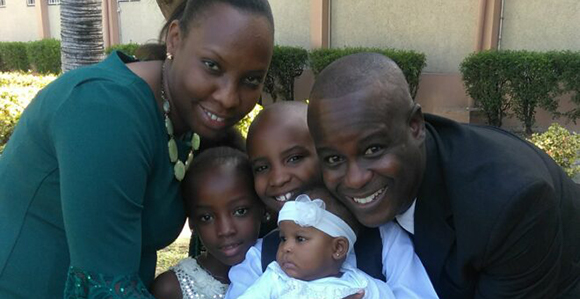
Nadege and Jean Rossely Bernard pose for a photo with their children at the baby blessing of their youngest child in January, 2019. Photo courtesy of Alice Rampton.
Article Highlights
- Jean Rossely Bernard and his wife, Nadege, lost their home and possessions in the earthquake.
- Six months after the earthquake, Jean and Nadege were sealed in the Santo Domingo Dominican Republic Temple.
- In the 10 years since the quake, Jean served as a bishop, finished his bachelor’s degree, and became a father of three.
“For me, when you fail, it’s [an opportunity to] try doing the thing another way. . . . I always wait [for] God to give me courage, to give me strength to do the right thing. . . . When I start to do something, I make sure to finish it.” —Jean Rossely Bernard
Related Links
Jean Rossely Bernard left for his class at the university abnormally late the afternoon of January 12, 2010. About 40 minutes behind his usual schedule, the 31-year-old student boarded a “tap-tap”—a ride-share bus typical in Haiti—and began inching toward school through congested streets.
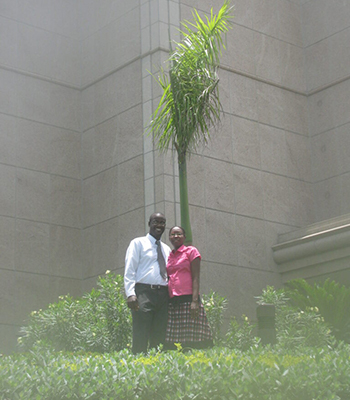
Jean Rossely and Nadege Bernard pose outside the Santo Domingo Dominican Republic Temple, where they were sealed on July 7, 2010. Photo by Alice Rampton.
As the bus pulled up to the university, shock waves ripped through the city of Port-au-Prince.
He jumped off and onto the crumbling street, falling down each time he tried to stand while dust and smoke flooded the air. As the shaking subsided, he looked up to see the university collapsed.
If he had been in the building for class, Bernard said, he would be dead.
After trying to pull survivors out of the rubble, Bernard rushed to check on his mother and mother-in-law, who lived nearby. Finding them unhurt, he cut across the city for three hours on foot to look for his wife, Nadege, at their apartment. Cell service would be out for hours, and the unstable city he navigated now held tens of thousands of bodies under its ruined landscape. The only way for him to know if Nadege had survived was to find her himself.
She was not at home. Nadege had run out of the apartment building as soon as she felt the earthquake. Hurrying in the opposite direction to look for Jean Rossely at the university, she saw how many people had been killed by the crushing rubble, and dread overwhelmed her. No one in the area had seen her husband.
At her mother’s house, she learned that Jean Rossely had been looking for her after the earthquake, and she wept in relief.
He had no reason to leave late for the university that day—his life was saved, Jean Rossely said, by God.
Finding Refuge in the Church
Though fortunate to be physically unharmed, the Bernards lost their home and possessions in the magnitude 7.0 earthquake—as did another 1.5 million Haitians suddenly rendered homeless—and they could not return to their apartment.
Then they remembered their local meetinghouse of The Church of Jesus Christ of Latter-day Saints.
The couple, who had celebrated their first wedding anniversary only two days earlier, joined hundreds of other Haitians seeking temporary shelter in tents and under blankets on the Centrale Ward building grounds. Church buildings were some of the city’s few structures left standing and safe to enter in the days following the earthquake.
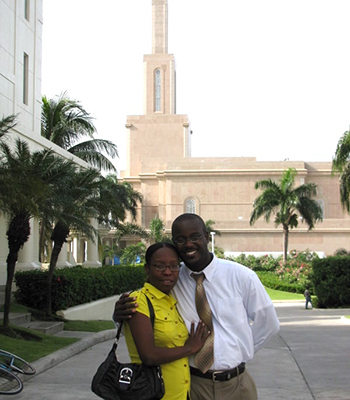
Jean Rossely and Nadege Bernard pose outside the Santo Domingo Dominican Republic Temple, where they were sealed on July 7, 2010. Photo by Alice Rampton.
About a week after the disaster, a volunteer team of 18 doctors and nurses sponsored by the Church arrived in Port-au-Prince and set up clinics at ward meetinghouses—the first at the Centrale building—to provide care to those with the most urgent needs.
Dr. Mark Rampton, one of the volunteer physicians, said all the local hospitals were operating in makeshift tent facilities outdoors because their buildings had collapsed. The estimated death count rose above 100,000.
“After the earthquake there was no clean water, no public water, no public electricity, no utilities. . . . A huge portion of the population of Port-au-Prince literally was out on the street. People were . . . collecting water in buckets that looked like chocolate milk,” Rampton recalled.
On the Church-sponsored medical team’s first day at the Centrale Ward building, the doctors and nurses asked for volunteers, including people who understood English to help with interpretation. Jean Rossely Bernard, who had taught himself English for years, offered to help and was paired up with Rampton, interpreting for him over the team’s two-week stay.
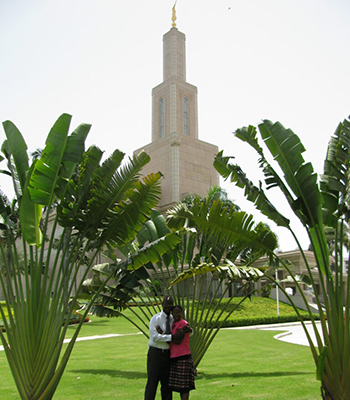
Jean Rossely and Nadege Bernard pose outside the Santo Domingo Dominican Republic Temple, where they were sealed on July 7, 2010. Photo by Alice Rampton.
The two “hit it off with each other” right away, Rampton said, and have maintained a friendship ever since.
At one of the clinics at the Centrale Ward meetinghouse, Rampton was present at a turning point in the Bernards’ lives.
Jean Rossely asked the staff to administer a pregnancy test to his wife, and the result was positive. To discover they were expecting their first child at that moment—amid the chaos caused by the earthquake—brought inexpressible joy, he said.
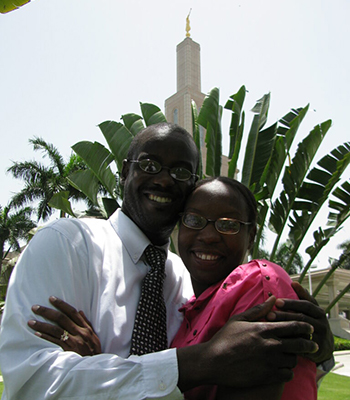
Jean Rossely and Nadege Bernard pose outside the Santo Domingo Dominican Republic Temple, where they were sealed on July 7, 2010. Photo by Alice Rampton.
Now aware of Nadege’s pregnancy, the couple decided she would stay in the countryside until conditions in Port-au-Prince improved. After living on meetinghouse grounds for about three months, Jean Rossely found a job—an answer to prayers—which allowed him to rent an apartment.
When the earthquake hit, Jean Rossely recalled, he was struck with fear that he would die before being sealed to Nadege. The couple had been saving money to visit the temple but had not yet had the opportunity. After the disaster, they felt a new sense of urgency to accomplish this goal.
To his surprise, Jean Rossely’s employer let him take a week off after only a month and a half of work, and he and Nadege were able to travel to the temple in July 2010. After a bumpy, 13-hour trip—and switching buses after the first one broke down—they arrived in Santo Domingo, Dominican Republic.
Nadege was pregnant and they were both exhausted, still recovering from the earthquake and nervous about setting foot in a country they had never visited—but they were determined to become an eternal family. The Bernards were sealed in the temple on July 7, 2010.
Mark Rampton and his wife, Alice, helped organize the temple trip and joined the Bernards in Santo Domingo for the ceremony as part of a visit to the Dominican Republic, where their son had served a mission.
Jean Rossely said he and Nadege felt grateful and happy to know “that we can be together forever and our son would be born in the covenant.”
When asked about the future he envisions for his children, Jean Rossely said he wants his children to grow in the gospel, get married in the temple, and earn college degrees. “I want the best future for them” in their chosen professions, he said. “But what I want more,” he added, is for them “to keep the gospel.”
Opportunities to Serve
In the 10 years since the earthquake, Jean Rossely Bernard’s life has been defined by continued service to others and commitment to the gospel of Jesus Christ. As his family expanded to include three children, now one, eight, and nine years old, he held various callings in the Church, worked, and earned a college degree.
“I have a mission on the earth to help people, to help my family, and to help those in need,” he said.
In 2011, he was called as an area assistant auditor for the Church. Meanwhile, he continued to pursue his education, studying online so that he could work to support his family at the same time.
Jean Rossely cites principles he learned at church as motivation to attain an education: “The Church [teaches] you have to be self-sufficient. We have to be able to grow, to help our family.” He added that he was willing to sacrifice by going to school while working to take care of his family because “education is the base” that allows one to find good employment.
He graduated in 2014 with a bachelor’s degree in business management.
His belief in the power of education influenced his approach to his next calling, when in September 2015 he received a call to serve as the bishop of the Centrale Ward. Jean Rossely said he enjoyed the increased interaction with ward members in his new calling, and he especially valued the opportunity to work with the ward’s 78 young women and young men.
“The young people . . . really need my love,” he said, adding that he emphasized the need for them to prioritize their schooling.
President Berthony Théodor, the Bernards’ stake president, said Jean Rossely did his best to follow President Russell M. Nelson’s direction to bishops to focus on the youth, which he reiterated at the most recent general conference.
In Haiti, where families’ temporal needs are often demanding, it can be difficult for a bishop to concentrate on the youth, President Théodor said. But Jean Rossely worked to help youth attend both seminary and school—which can be challenging due to the Centrale Ward’s location in downtown Port-au-Prince, where demonstrations have caused schools and other public buildings to close.
“God needs educated people,” Jean Rossely told the youth. “When you are educated, you are a light for where you are living and you are a light for your school. You are a light for a lot of people who can follow you.”
To teach them about how education leads to a better future, he led activities, read scriptures, invited others to teach, and gave examples from his own life, Jean Rossely said. “I showed them where I was from . . . and where I am now.”
“I always prayed and asked God to give me strength and to give me new ideas, to give me a way to help the people,” he said. His favorite scripture is 1 Nephi 3:7, because he believes “when God asks you to do something, He always gives you a way to do it.”
Haitians, Jean Rossely said, are “a resilient people. We don’t give up.”
The Church continues to grow in Haiti, where there are more than 23,000 members. The country’s first temple was dedicated September 1, 2019.
President Théodor said of the members in Haiti, “Their biggest strength is their desire to follow the leaders. They love the Savior. They love the Church, and they always want to be there.”
Amid recent political unrest that has closed schools and government agencies and disrupted communication, President Théodor said he and other leaders thought there might be no members at sacrament meetings. “But . . . they impressed me,” he said. “They go to church dressed with their best Sunday clothing, and this is really an indicator that they love the Savior and they want to receive His blessings.”
When asked whether he has felt moments of discouragement over the past decade, Jean Rossely laughed and responded: “For me, when you fail, it’s [an opportunity to] try doing the thing another way. . . . I always wait [for] God to give me courage, to give me strength to do the right thing. . . . When I start to do something, I make sure to finish it.”
He was released as bishop in 2019 after moving to the United States to seek political asylum.
His faith has allowed him to remain optimistic despite challenges—even disasters as life-altering as the 2010 earthquake. Jean Rossely said he follows Jesus Christ because he knows “He will lead me to the best places.”
“I have always had hope in Christ,” he said. “When we go through trials, we must not succumb to them; we need to have hope. We need to have courage. We need to conquer our problems, . . . because I know that problems are made for us, and we need to overcome them by faith.”
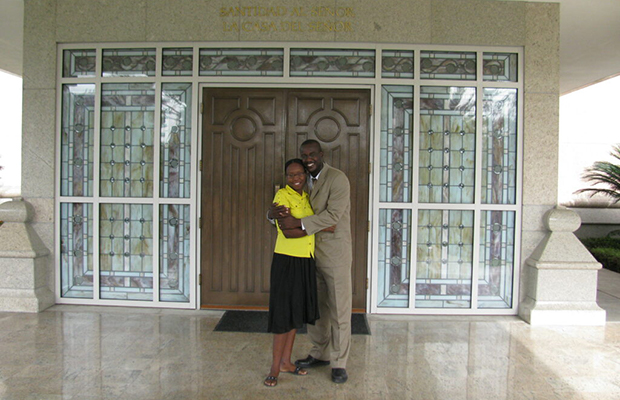
Jean Rossely and Nadege Bernard pose outside the Santo Domingo Dominican Republic Temple, where they were sealed on July 7, 2010. Photo by Alice Rampton.
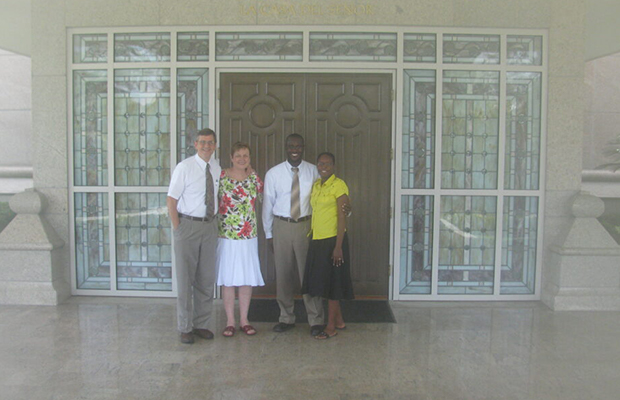
Jean Rossely and Nadege Bernard pose for a photo with Mark and Alice Rampton outside the Santo Domingo Dominican Republic Temple, where the Bernards were sealed on July 7, 2010. Photo by Alice Rampton.
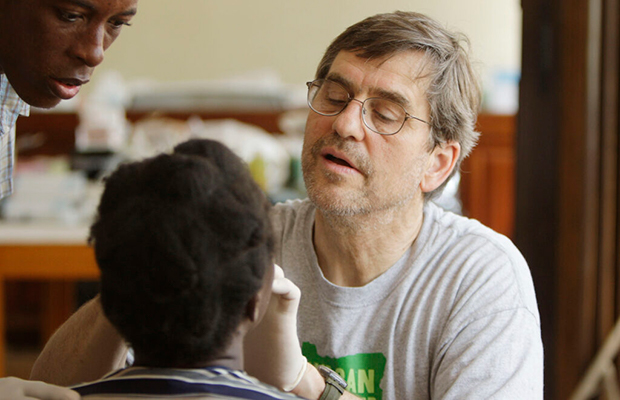
Dr. Mark Rampton cares for earthquake victims at a clinic set up in the Centrale Ward meetinghouse in Port-au-Prince, Haiti, Thursday, January 21, 2010. Photo by Jeffrey D. Allred, Deseret News.
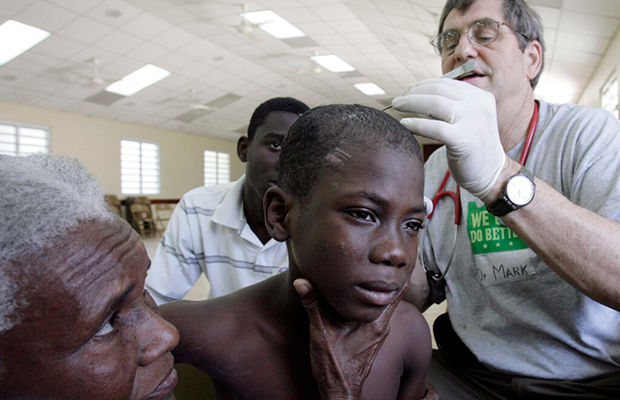
Dr. Mark Rampton cares for patient Loubens Pierre as his mother, Renette Charles, stays close at the Croix-des-Missions Ward meetinghouse of The Church of Jesus Christ of Latter-day Saints in Port-au-Prince, Haiti, on January 25, 2010. Photo by Jeffrey D. Allred, Deseret News.
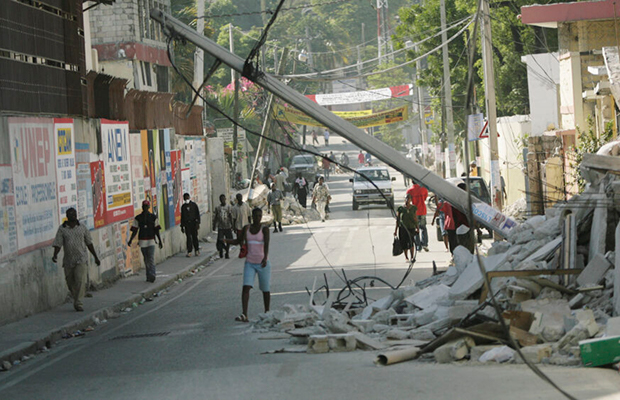
Haitians walk near the rubble of collapsed buildings and power lines in Port-au-Prince, Haiti, on January 19, 2010—a week after a 7.0 magnitude earthquake struck the region. Photo by Jeffrey D. Allred, Deseret News.
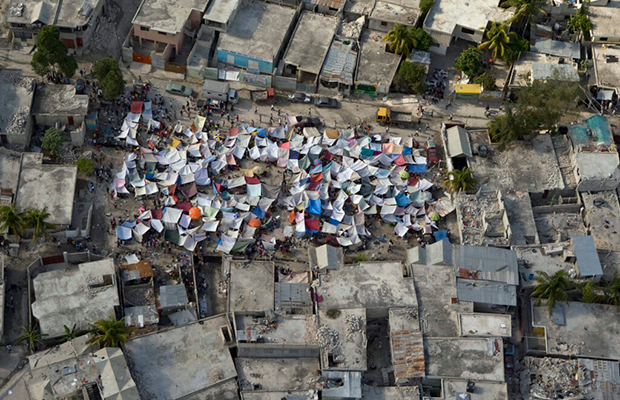
Haitians set up impromptu tent cities in the capital after a magnitude 7.0 earthquake hit Port-au-Prince on January 12, 2010. Photo courtesy of Logan Abassi.
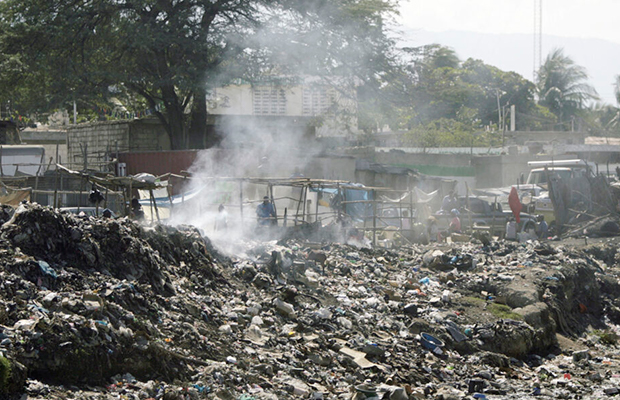
Haitians shelter in temporary structures in Port-au-Prince, Haiti, on January 20, 2010, after homes and other buildings were damaged in the January 12 earthquake. Photo by Jeffrey D. Allred, Deseret News.
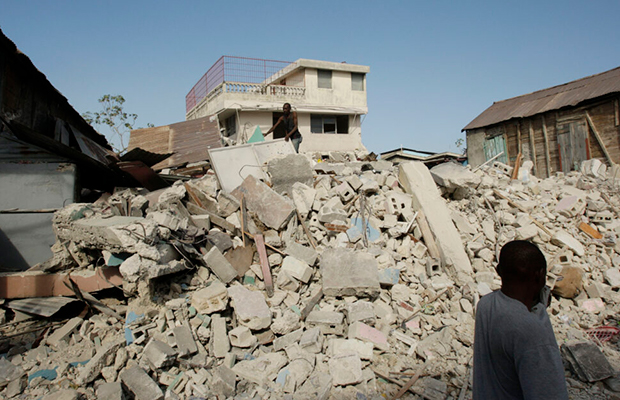
A passerby covers his mouth from the dust as he walks in Port-au-Prince, Haiti, on January 19, 2010—one week after a 7.0 magnitude earthquake struck the region. Photo by Jeffrey D. Allred, Deseret News.
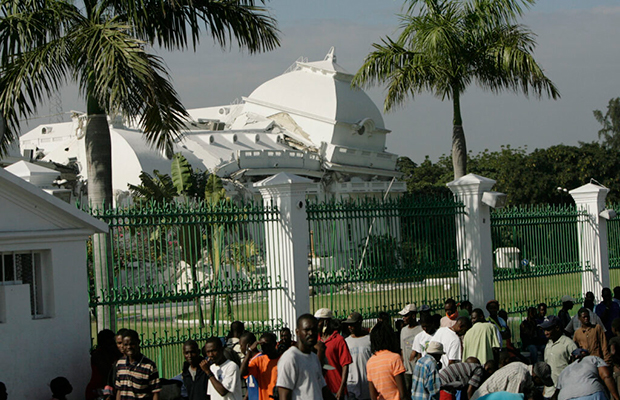
Haitians stand in line for supplies near the partially collapsed National Cathedral in Port-au-Prince, Haiti, on January 19, 2010—one week after a magnitude 7.0 earthquake hit the region. Photo by Jeffrey D. Allred, Deseret News.
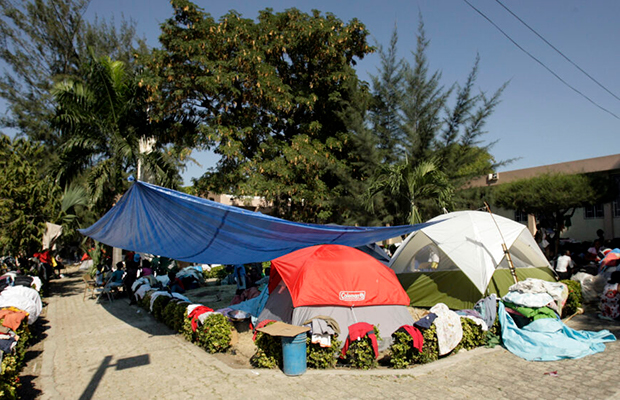
Earthquake victims take refuge on the Centrale Ward meetinghouse grounds in Port-au-Prince, Haiti, on January 21, 2010. Photo by Jeffrey D. Allred, Deseret News.
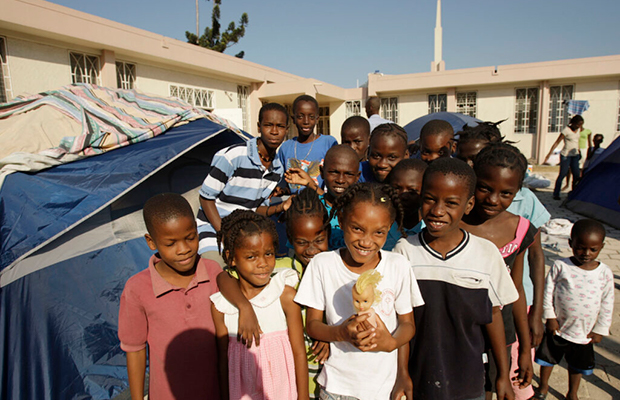
Children stand outside the Centrale Ward meetinghouse of The Church of Jesus Christ of Latter-day Saints in Port-au-Prince, Haiti, on January 23, 2010. Members of the Church and others stayed on the grounds because they had nowhere else to go in the aftermath of the January 12 earthquake. Photo by Jeffrey D. Allred, Deseret News.
